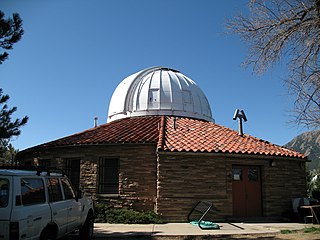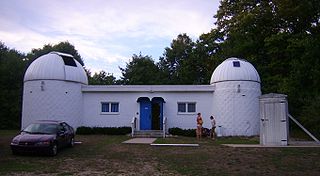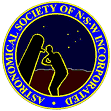
The Kitt Peak National Observatory (KPNO) is a United States astronomical observatory located on Kitt Peak of the Quinlan Mountains in the Arizona-Sonoran Desert on the Tohono Oʼodham Nation, 88 kilometers (55 mi) west-southwest of Tucson, Arizona. With more than twenty optical and two radio telescopes, it is one of the largest gatherings of astronomical instruments in the Earth's northern hemisphere.

The Pic du Midi de Bigorre or simply the Pic du Midi is a mountain in the French Pyrenees. It is the site of the Pic du Midi Observatory.

The Kopernik Observatory & Science Center (KOSC), is a public observatory in Vestal, New York opened to the public on 16 June 1974 by the Kopernik Society of Broome County to commemorate the 500th anniversary of the birth of the astronomer Nicolaus Copernicus in 1973. Its mission is to offer hands-on investigations and outreach programs for educating all ages about astronomy and science using advanced optical telescopes, computers and other tools. It is the first science laboratory facility in New York State designed for K-12 teachers, students and their families, and has been one of the best-sited and best equipped public observatories in the Northeast United States for nearly the last 40 years.

The Roger B. Chaffee Planetarium, named for astronaut Roger B. Chaffee, was constructed in the early 1960s as part of the Public Museum of Grand Rapids. The facility initially featured a 30-foot (9.1 m) plaster dome and a Goto Optics mechanical star projector. Among the planetarium's first shows was "Star of Wonder", an astronomical attempt at an explanation of the Star of Bethlehem. The show received positive reviews in the Grand Rapids area and remained in the Chaffee's catalogue for several years.

Mount Laguna Observatory (MLO) is an astronomical observatory owned and operated by San Diego State University (SDSU). The telescope was operated in partnership with the University of Illinois at Urbana-Champaign (UIUC) until 2000. MLO is located approximately 75 kilometers (47 mi) east of downtown San Diego, California, on the eastern edge of the Cleveland National Forest, in the Laguna Mountains on the SDSU Astronomy Campus near the hamlet of Mount Laguna. MLO was dedicated on June 19, 1968, seven years after SDSU's Department of Astronomy became an independent academic department of SDSU's College of Sciences. The dedication took place during the 1968 summer meeting of the Astronomical Society of the Pacific.
The Amateur Astronomers Association of Pittsburgh (AAAP) is an Astronomical Organization founded on June 9, 1929, by Chester B. Roe and Leo J. Scanlon. Since its establishment, it has grown to have over 500 members and operates two observatories in the Pittsburgh region: the Nicholas E. Wagman Observatory and the Mingo Creek Park Observatory. The club also sponsors many star parties that are open to the public throughout the year.

The James Richard Jewett Observatory is an astronomical observatory owned and operated by Washington State University. It is located in Pullman, Washington (US). It houses the largest refracting telescope in the state of Washington. The 12-inch lens was originally ground and polished between 1887 and 1889 by Alvan Clark & Sons for an amateur astronomer, who died before the telescope could be assembled. The lens was put into storage, and was purchased by the university when it came up for auction in the 1950s. Its present dome was dedicated in 1953 and it is named after the father of a supporter of the observatory, Mr. George Jewett of Spokane.

Sommers–Bausch Observatory is an astronomical observatory located on and owned by University of Colorado Boulder. The building was initially completed in 1953 and named after Elmer E. Sommers and Carl L. Bausch.

Mount Cuba Astronomical Observatory is an astronomical observatory is located at 1610 Hillside Mill Road, Greenville, Delaware, United States. This observatory is home to a 0.6-meter telescope used by the Delaware Astronomical Society, the University of Delaware, and the Whole Earth Telescope. The DAS is composed of interested amateurs and engages in astronomy education and public outreach. Meetings are held the third Tuesday of each month at the Mt. Cuba Astronomical Observatory.
Vega–Bray Observatory is an astronomical observatory owned and operated by Astronomers Inn located on a small hill overlooking the San Pedro River Valley, just east of Benson, Arizona (US). Founded in 1990 by Max Bray, an optician and Dr. Eduardo Vega, a pathologist, it is home to the Hoot–Vega Radio Telescope.
Martz Observatory, now known as the Martz-Kohl Observatory, is a public, not-for-profit organization devoted to the amateur astronomer. The emphasis of the association is observational astronomy, well-rooted in public education and enjoyment of the starry skies. It was founded by, and eventually named after, Marshal Martz, an amateur astronomer from Jamestown, NY who built the first large telescope ever used at the observatory.
Warren Rupp Observatory is an astronomical observatory owned and operated by Richland Astronomical Society. Built in 1985, it is located on the Friendly House Hidden Hollow Camp south of Mansfield, Ohio, United States.

The James C. Veen Observatory is an astronomical observatory owned and operated by the Grand Rapids Amateur Astronomical Association. Built during the 1960s and opened in 1970, it is located 3.6 miles west-southwest of Lowell, Michigan, United States. Its two domes house the main instruments and a roll-off structure houses a 17-inch Dobsonian.
Brooks Astronomical Observatory is an astronomical observatory owned and operated by Central Michigan University. It is located in Mount Pleasant, Michigan (USA). The observatory was established in 1964 and is located on the roof of the Brooks Hall science building. Both the building and observatory are named for Kendall P. Brooks, instructor of astronomy and other subjects in the period of 1910-1947.
The Royal Astronomical Society of Canada (RASC) is a national, non-profit, charitable organization devoted to the advancement of astronomy and related sciences. At present, there are 30 local branches of the Society, called Centres, in towns and cities across the country from St. John's, Newfoundland, to Victoria, British Columbia, and as far north as Whitehorse, Yukon. There are about 5100 members from coast to coast to coast, and internationally. The membership is composed primarily of amateur astronomers and also includes numerous professional astronomers and astronomy educators. The RASC is the Canadian equivalent of the British Astronomical Association.

Fuertes Observatory is an astronomical observatory located on the North Campus of Cornell University in Ithaca, New York. The observatory was designed by L.P. Burnham, Cornell Professor of Architecture and completed in fall of 1917. It was originally used by the Civil Engineering Department as an instructional field office for navigation and surveying. Today, the observatory is primarily used for public outreach, welcoming over two thousand visitors per year with open houses on clear Friday nights.

J A Jones Hoober Observatory is a privately owned observatory located in South Yorkshire, England near to the villages of Hoober and Wentworth, 4 miles (6.4 km) North-northwest of Rotherham. It can be found about 300 metres (0.19 mi) east of Hoober Stand. The observatory is owned and operated by Mexborough & Swinton Astronomical Society (NPO).

The Peach Mountain Observatory (PMO) is an astronomical observatory owned and operated by the University of Michigan (UM). It is located near the village of Dexter, Michigan (USA), about 20 kilometers (12 mi) northwest of Ann Arbor. It was opened in 1955, and is used for research, instruction, and amateur observing.

The Astronomical Society of New South Wales (ASNSW) is an amateur astronomy club in the state of New South Wales, Australia, founded in 1954.

The Astronomical Society of Victoria (ASV) is an amateur astronomy club in the state of Victoria, Australia. It was founded in 1922, making it one of the oldest such clubs in the country, and with some 1500 members it claims to be one of the largest amateur astronomy organisations in the southern hemisphere. Membership is open to all with an interest in astronomy, and the society caters for people with a wide range of ages, backgrounds, abilities and interests.













